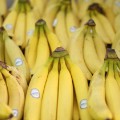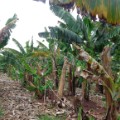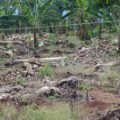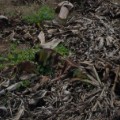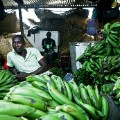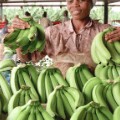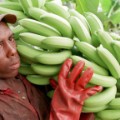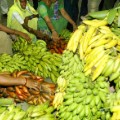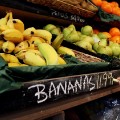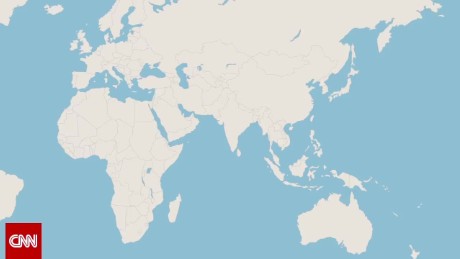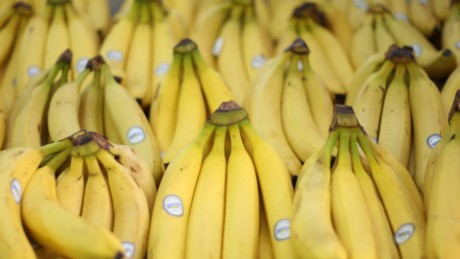(CNN)Fifty years ago, we were eating better bananas.
They tasted better, they lasted longer, they were more resilient and didn't require artificial ripening. They were -- simply put -- a better fruit, because they belonged to a different species, or cultivar in banana parlance.
It was called Gros Michel and it remained the world's export banana until 1965.
That year, it was declared commercially extinct due to the Panama disease, a fungal disease that started out from Central America and quickly spread to most of the world's commercial banana plantations, leaving no other choice but to burn them down.
The banana industry was in deep crisis, and had to look for alternatives. It settled with the Cavendish cultivar, which was deemed an inferior product but carried the distinction of being immune to the disease. It was quickly adopted by banana growers worldwide.
Today, the Cavendish is a universal foodstuff, much like a Big Mac: supermarket bananas are pretty much identical anywhere you buy them.
That's because they have nearly no genetic diversity -- the plants are all clones of one another. The Cavendish is a monoculture, which means it's the only variety that most commercial growers plant every year. Which is also why it is now under threat itself, from a new strain of the Panama disease. And once it infects one plant, it can infect them all.
Fifty years on, one of the most popular commercial foods in the world is once again under threat.
A threat to Africa
There are hundreds of banana varieties in the world, but the Cavendish alone accounts for nearly the totality of exports.
"Starting in the late 1980s, banana growers realized more diversity was needed to prevent the problem from happening again. They were begging their bosses for it, but it never happened," Dan Koeppel, author of the book "Banana: The fate of the fruit that changed the world," told CNN.
Banana Facts
- The banana plant is not a tree, but the world's largest herb.
- The fruit itself is, botanically, a berry.
- Bananas are very slightly radioactive, as they naturally contain potassium-40, a radioactive isotope.
- They are grown in over 100 countries.
- India is the world's largest producer.
- Ecuador is the world's largest exporter.
The disease now has a different name, "Tropical Race 4," and it started out in Malaysia around 1990, but it's otherwise very similar to the one that wiped out the Gros Michel: "It's caused by a really common type of fungus called Fusarium, which was probably already in the soil there. A single clamp of contaminated dirt is enough to spread it like wildfire, and it can be transported by wind, cars, water, creating an infection wherever it goes," explained Koeppel.
"Everyone who's ever had athlete's foot knows how hard it is to get rid of a fungus."
The pathogen affects the plant's vascular system, preventing it from picking up water.
Since its "second coming," TP4 has spread to South-east Asia, then across thousands of miles of open ocean to Australia and finally, in 2013, to Africa.
"Its recent discovery in the Middle East and in Nampula, Mozambique, indicates that the disease is spreading and threatening bananas worldwide," George Mahuku, Senior plant pathologist for the International Institute of Tropical Agriculture, told CNN.
"It's a serious threat to livelihoods and food security in the Nampula province, country and the continent, should it spread. In Africa, bananas are critical for food security and income generation for more than 100 million people," he added.
Not just the Cavendish
Even though the disease appears to have spread to just two plantations in Mozambique, the impact on the local economy is already severe: "The disease has already cost Matanuska, the company that owns the plantations, about $7.5 million. A total of 230,000 plants have been affected and destroyed. At the current rate of infection, the farm is losing 15,000 plants per week, translating to $236,000 per week," said Mahuku.
With Matanuska contributing over $1.5 million per month to the local economy, the potential loss of livelihood is very real.
Mahuku's job is to coordinate efforts to slow down the disease, prompting collaboration from around 20 African countries: "The East and Central Africa region has over 50% of its permanent crop area under banana cultivation. That's around half of the African total, with an annual production of 20.9 million tonnes valued at $ 4.3 billion. Bananas are an indispensable part of life in this region providing up to one fifth of the total calorie consumption per capita. If TR4 were to spread into this region, the effects would be unimaginable."
Many of these bananas are not Cavendish, but local varieties, or "village bananas," and they are also under threat from the disease: "Preliminary results from evaluation of nine East African Highland bananas and plantains revealed that they can be infected with TR4. Only one cultivar remained disease free after eight months," said Mahuku.
There is also an issue of consumer trust associated with the discovery of the disease, according to Joao Augusto, a plant pathologist working with IITA in Mozambique: "One of the biggest threats is the negative perception that the rest of the world may have on perceived risk of the African banana. Although the spread of the pathogen through the fruit is almost nil, possible rejection of African banana exports could seriously damage the banana business in Africa."
Can it be stopped?
The disease is not more virulent than the one that killed the Gros Michel, but it's spreading because the bad practices from 50 years ago are still in place: "The banana industry is in denial about this, and standard agricultural quarantines like fencing the crops and cleaning the equipment are not enough," added Koeppel.
The only solution would be to burn the plantation down and start over, but with a different crop. Restarting with bananas doesn't work because the fungus stays in the soil.
A battle on two fronts
Africa is currently fighting another serious disease that affects bananas, called Xanthonomas wilt or BXW, a bacterial disease that started spreading from Uganda in 2001. Although mostly limited to East Africa and Congo, it significantly reduced crop yields at the time of its most virulent spread, around 2005. So far, no cultivar has been found to be resistant to the disease, which spreads through contaminated soil, tools, and insects.
That, however, means the end of the business: "I understand growers don't want to throw the towel," Koeppel noted.
In Africa, a 12-month emergency project funded by FAO is underway to tackle TP4, and Mahuku is optimistic that the disease can be contained to the areas where it has been observed: "To achieve this, financial resources are needed, otherwise inaction due to lack of resources will be catastrophic, especially for small farmers who depend on bananas for their livelihoods," he said.
According to Augusto, there aren't many options to effectively control the disease: "It cannot be eradicated, but it can be limited if a wide range of strong preventive and mitigation initiatives are put in place and rigorously implemented. In countries where the disease is endemic, the banana growers have learned to live with it."
Ultimately, history could well repeat itself and prompt banana growers to look for a new alternative. There is no good candidate at the moment, but hybrids and GMOs are being considered.
The disease is not the only problem, though. Just as the Cavendish is under attack from the pathogen, local varieties are under attack from the Cavendish: "India had about 600 varieties, but over the past two decades the Cavendish has pushed out and replaced many of those. And when you replace a varied multiculture with a monoculture, if a disease happens, you're in trouble: nature comes back and bites you," said Koeppel.
"Monoculture to me is just as much a disease as TP4," he added.
While diversity has been embraced by most other vegetable and fruit industries, the Cavendish -- called "the hotel banana" in India -- is still the only banana in town in most export markets.
Hopefully its dominance won't lead to its downfall.












